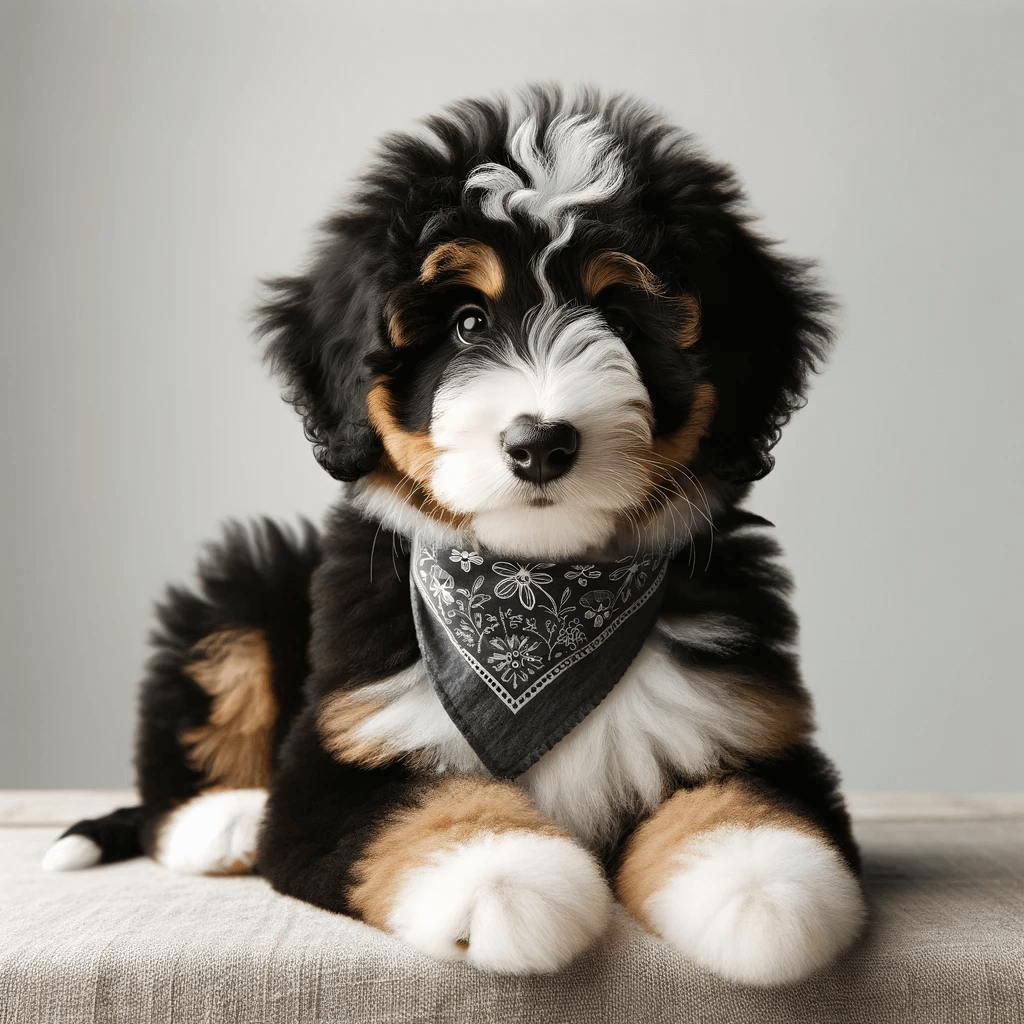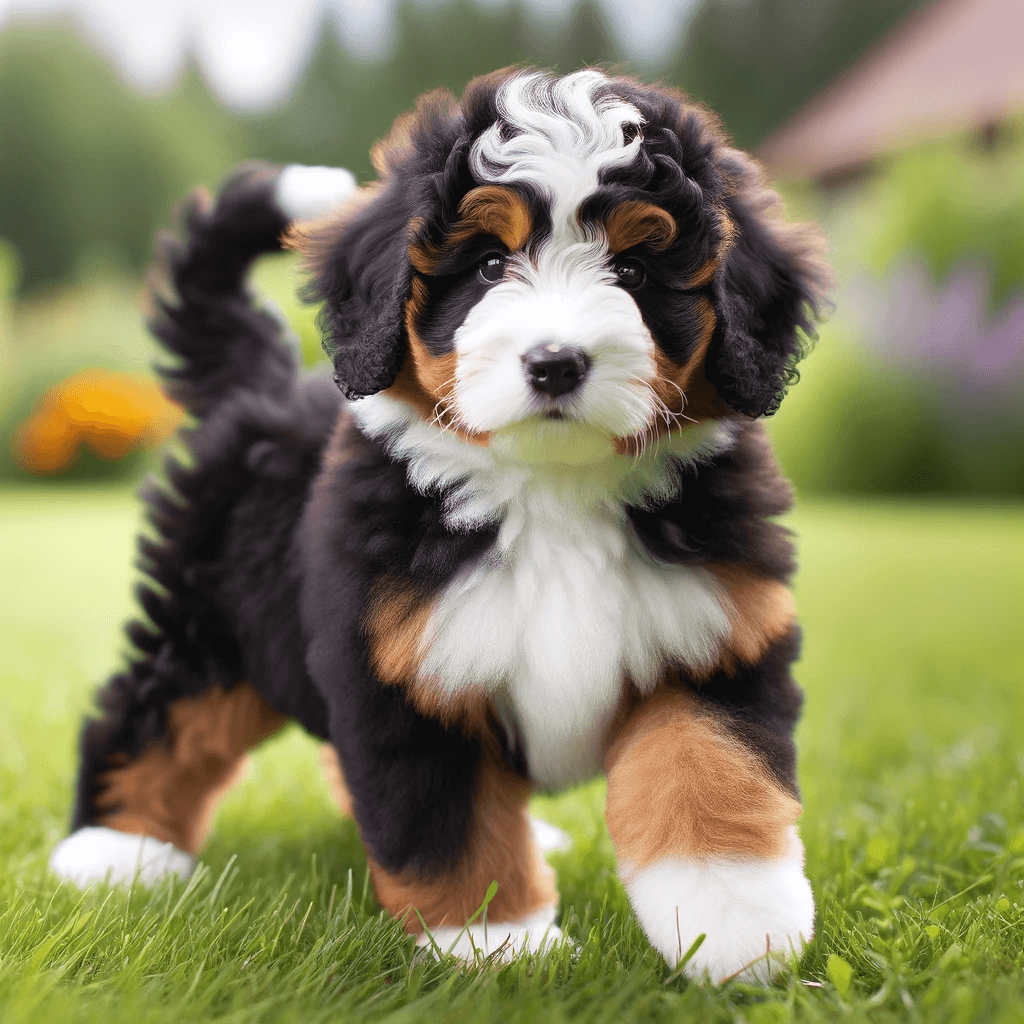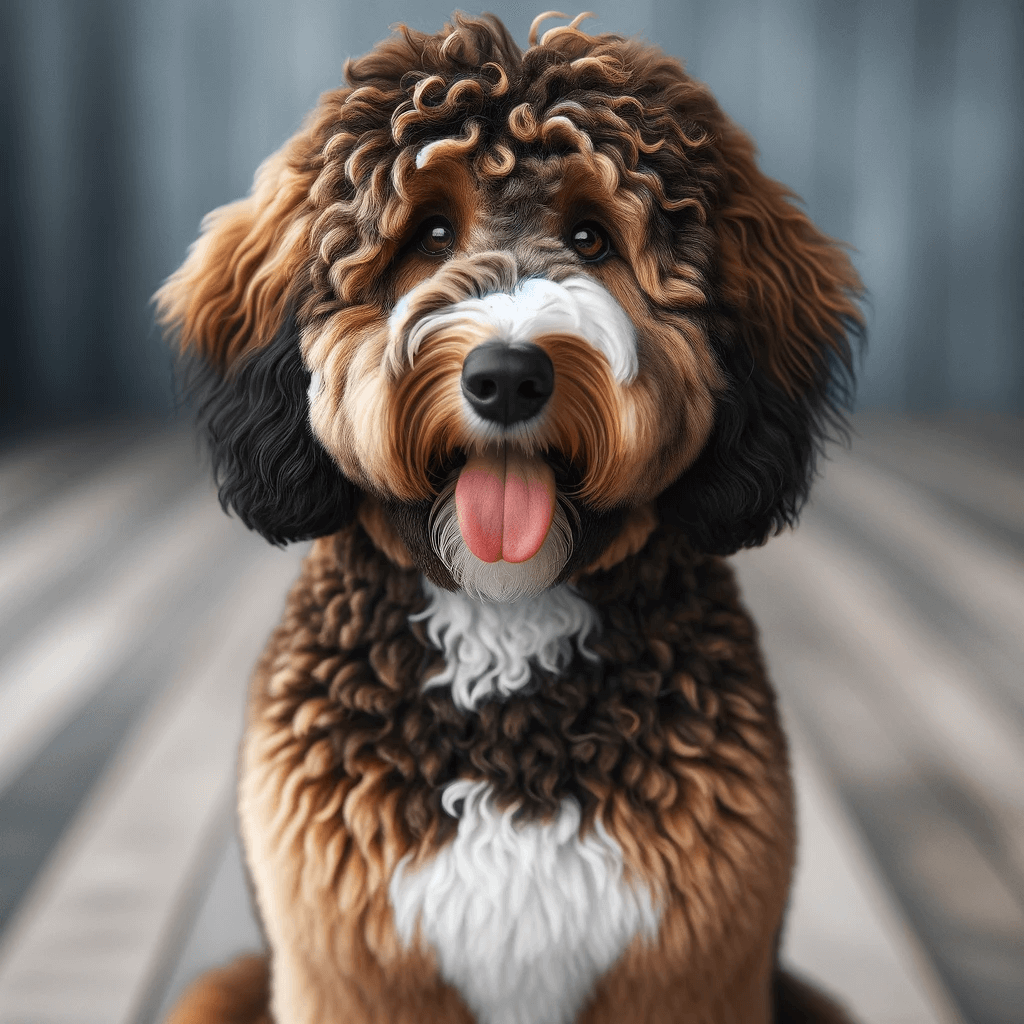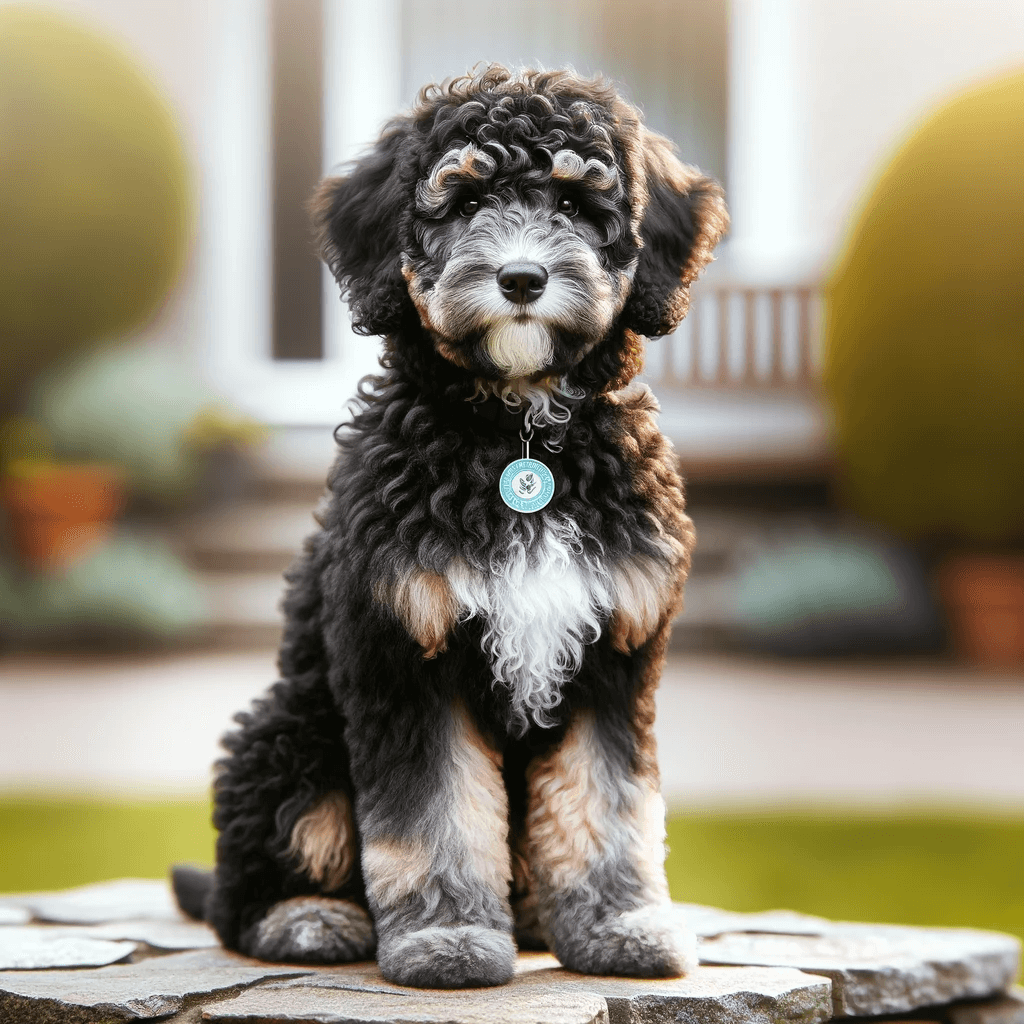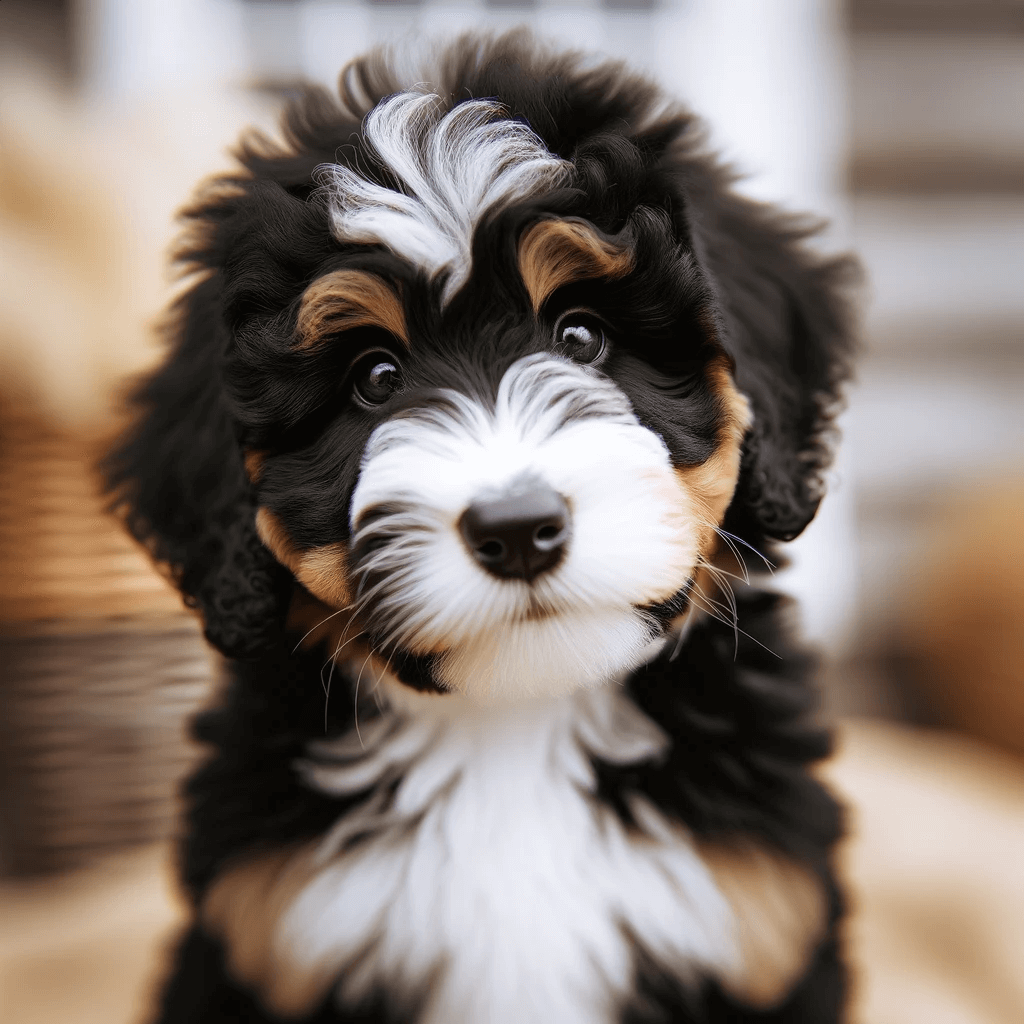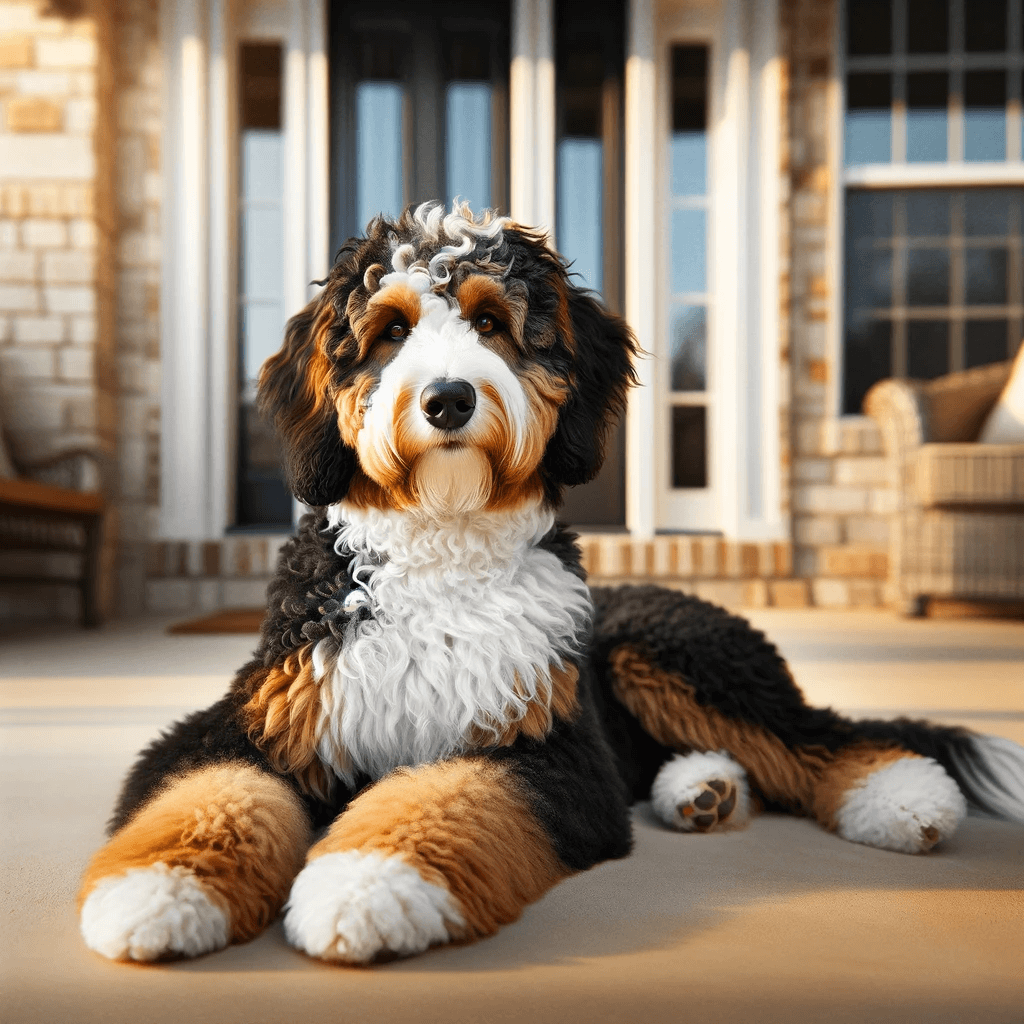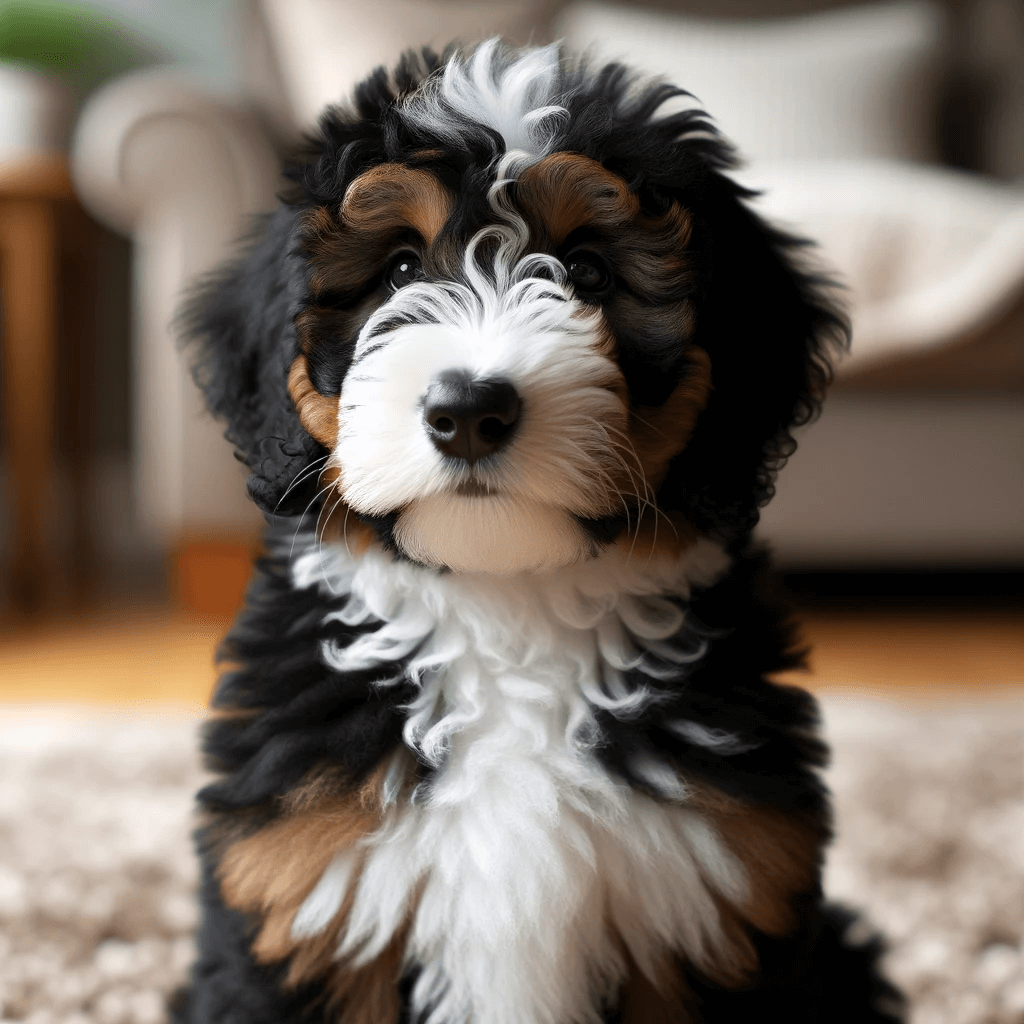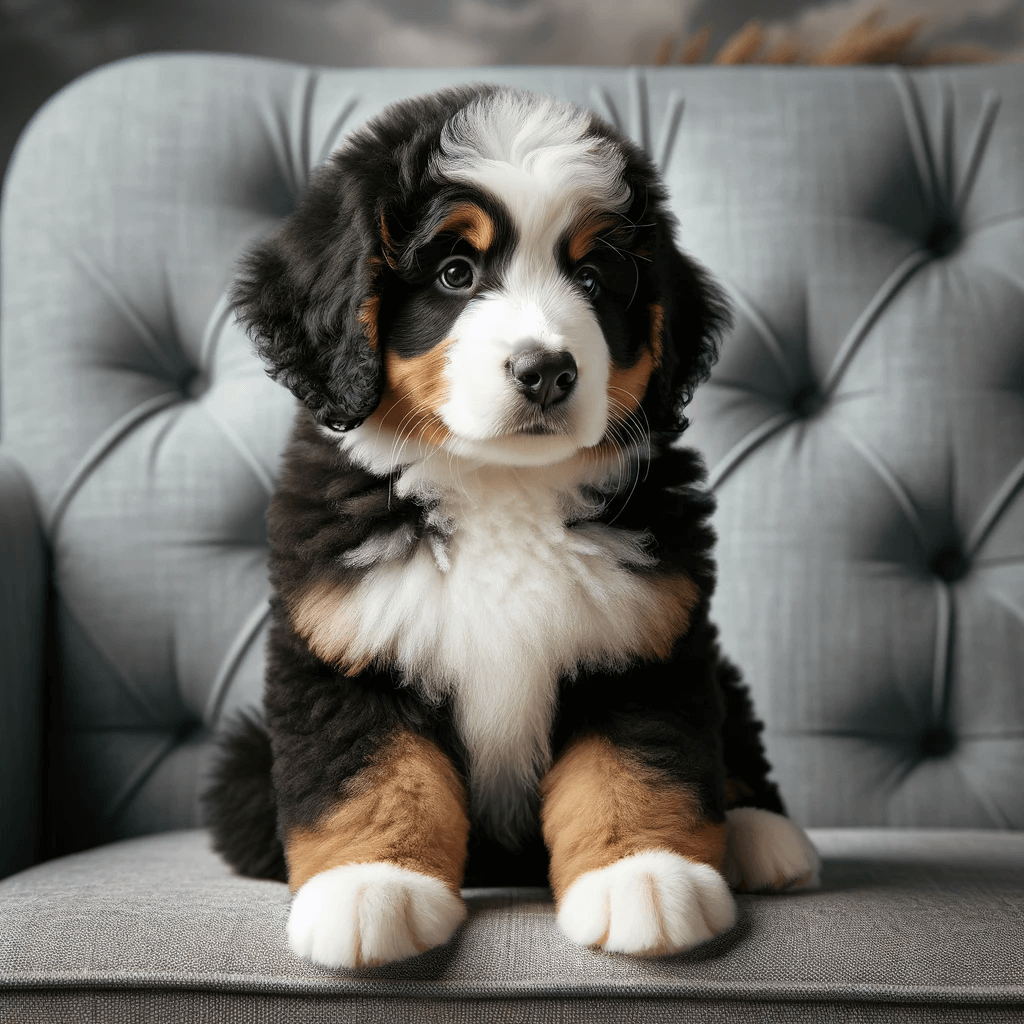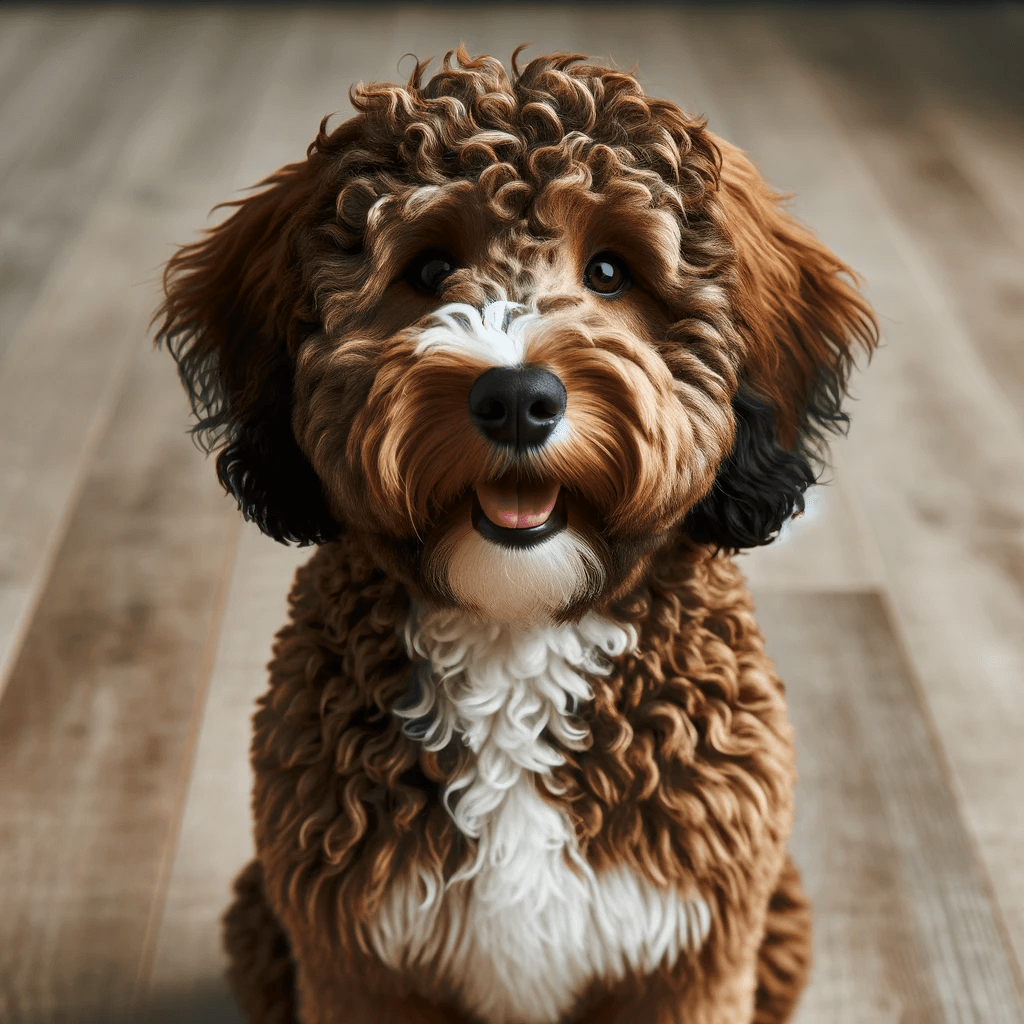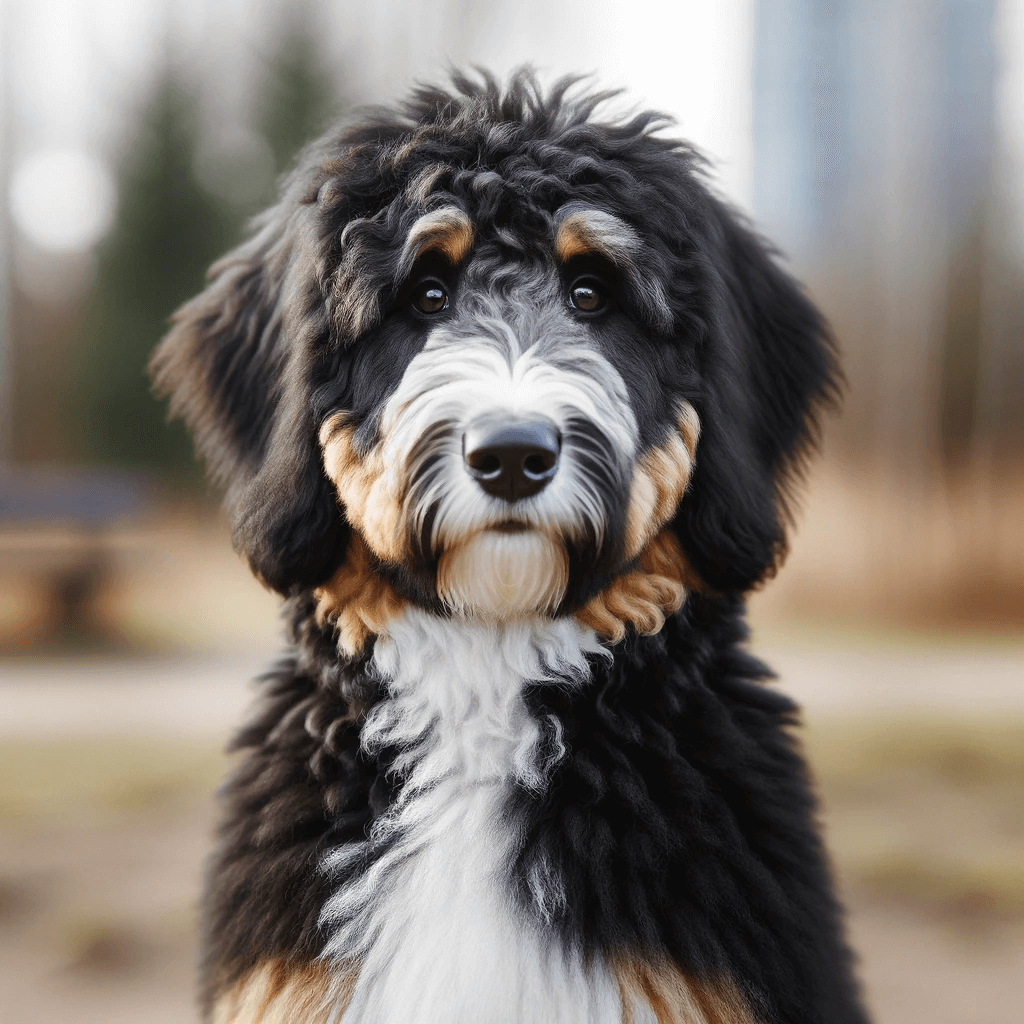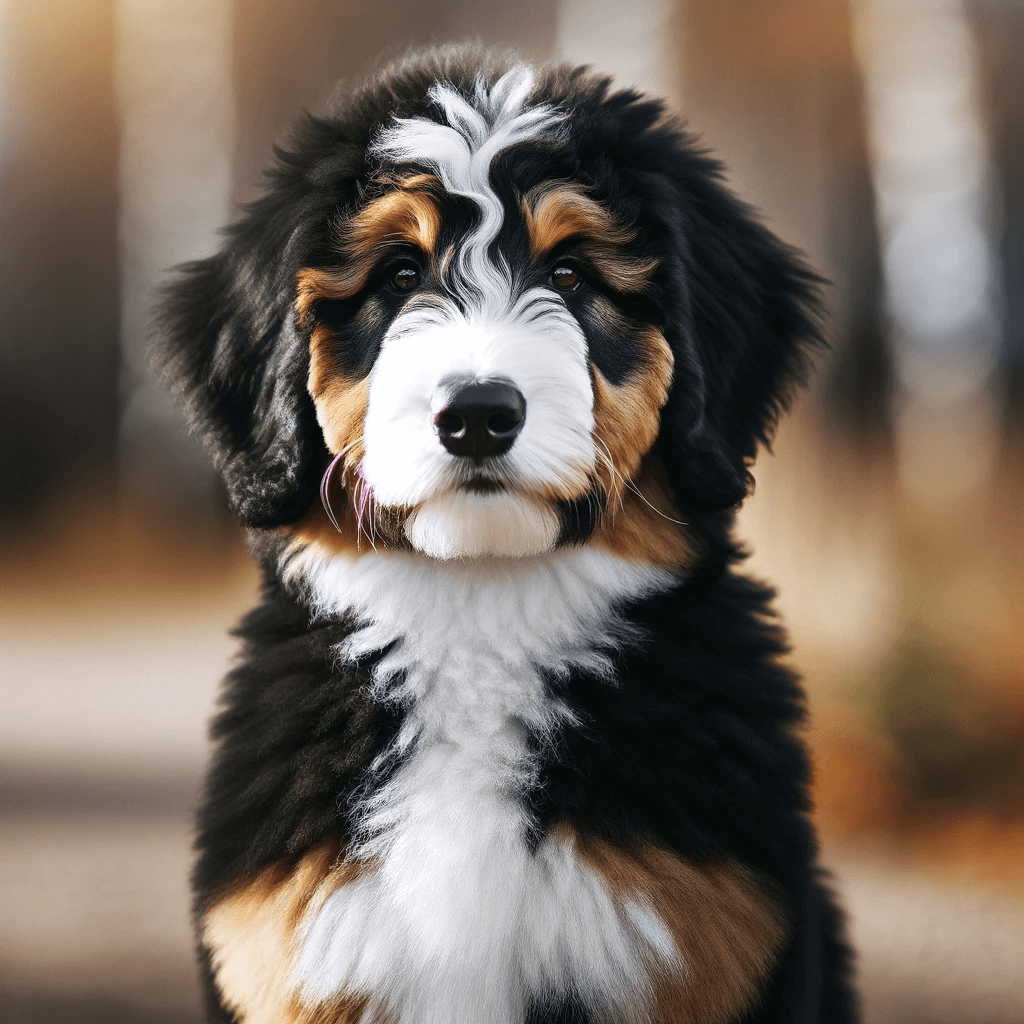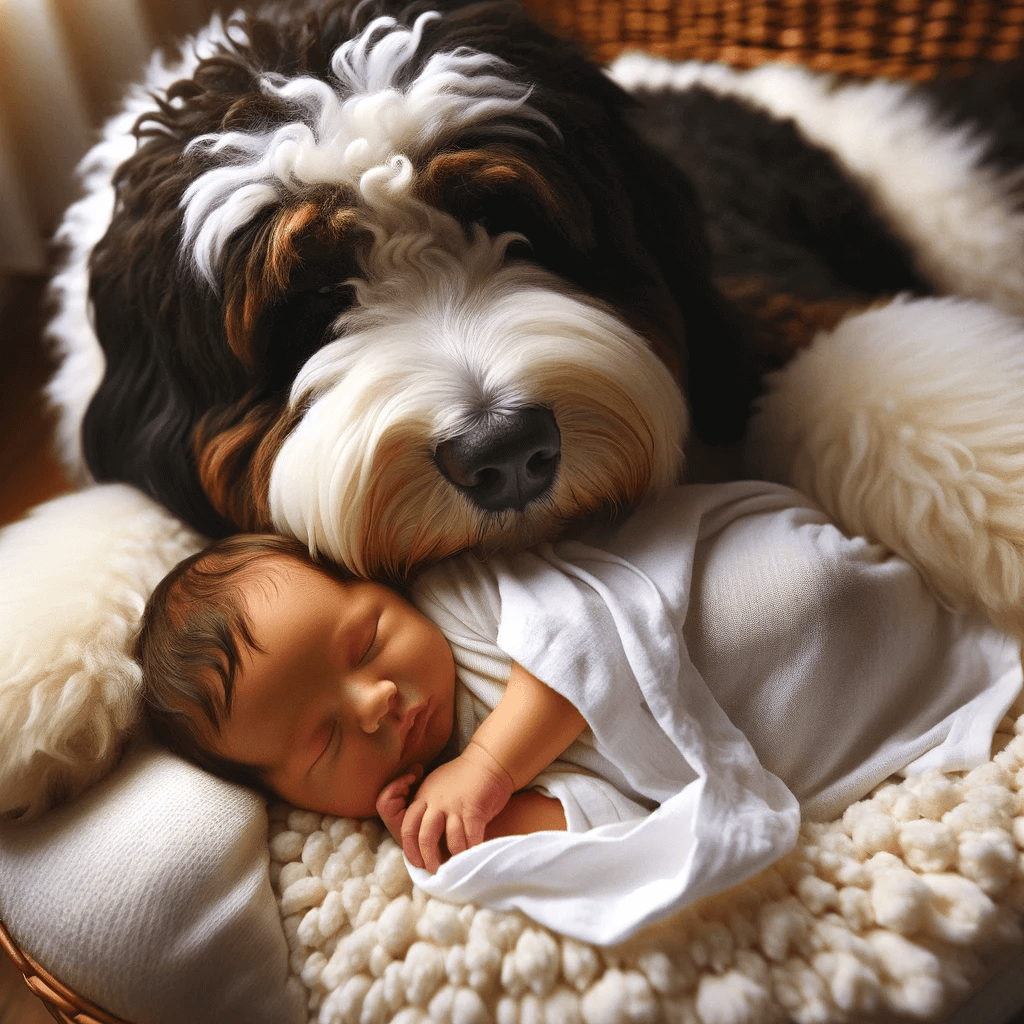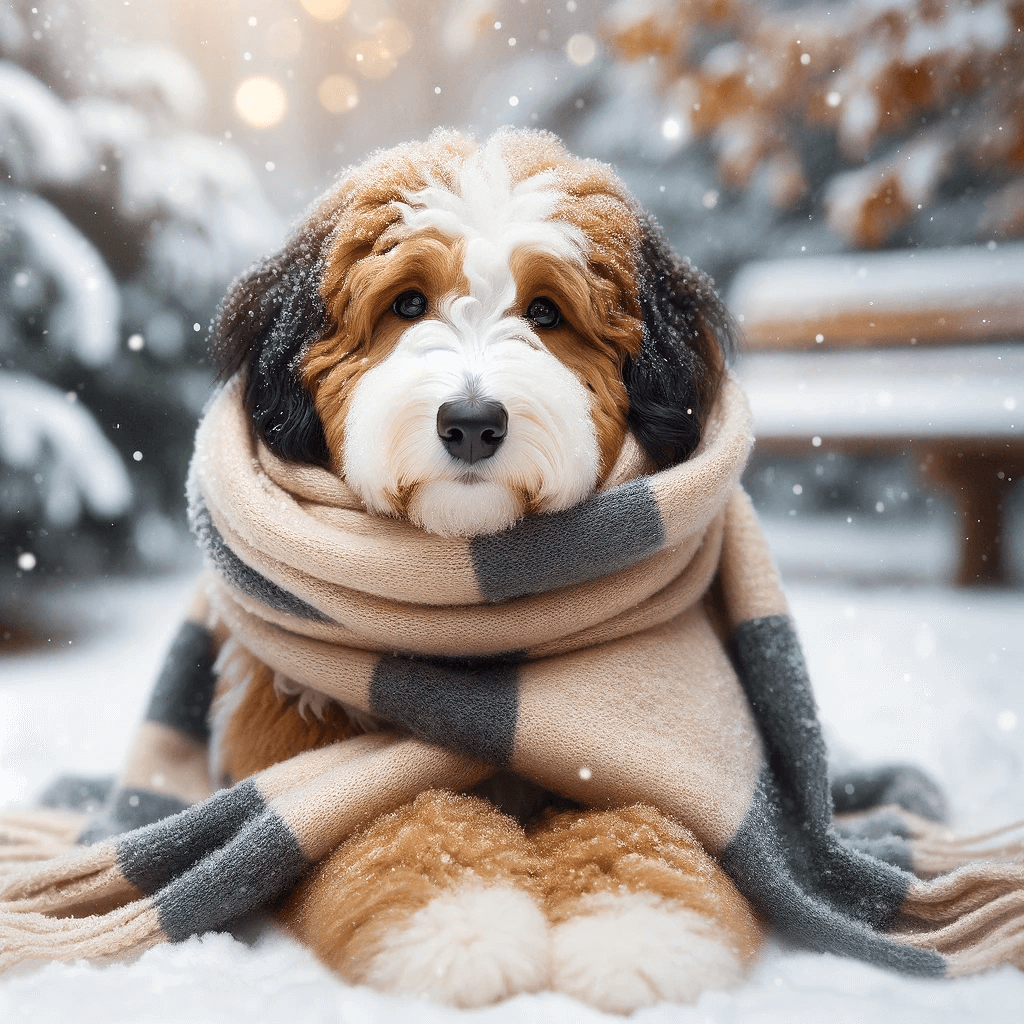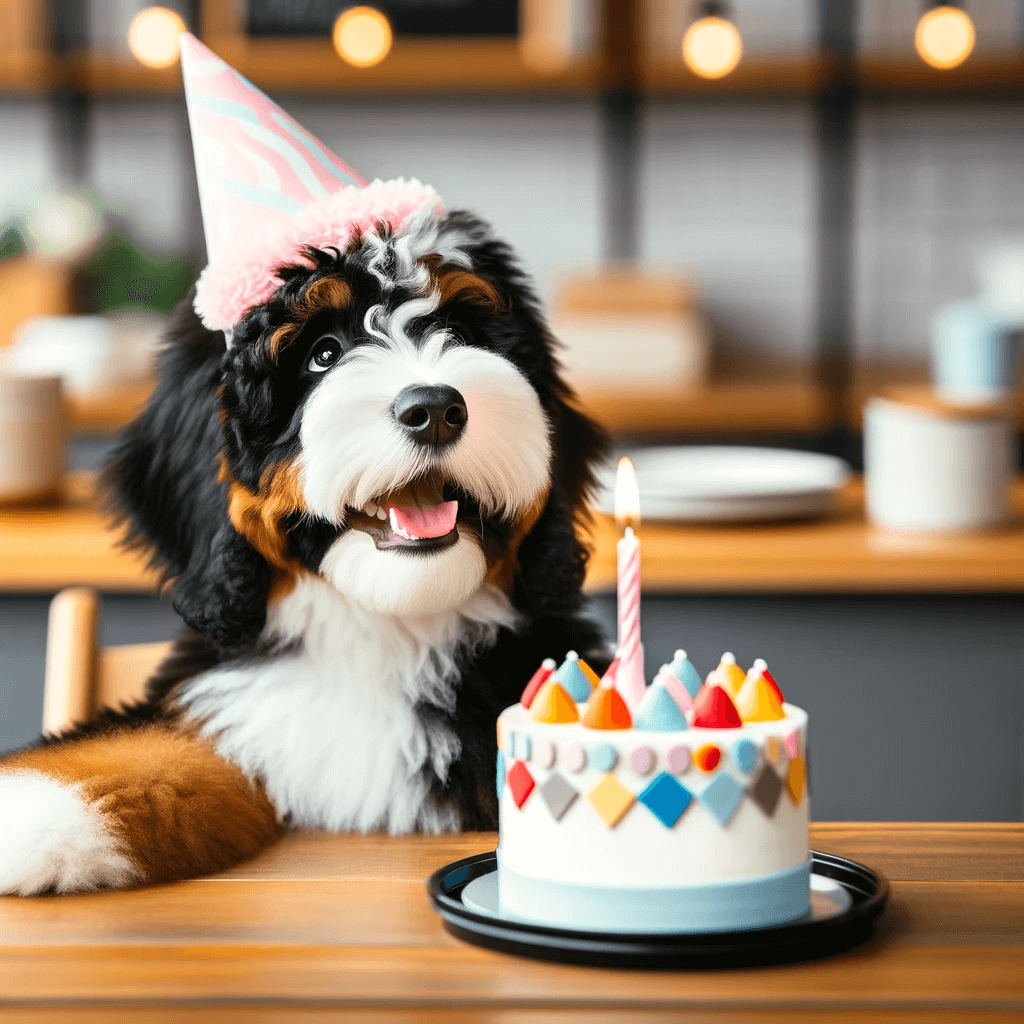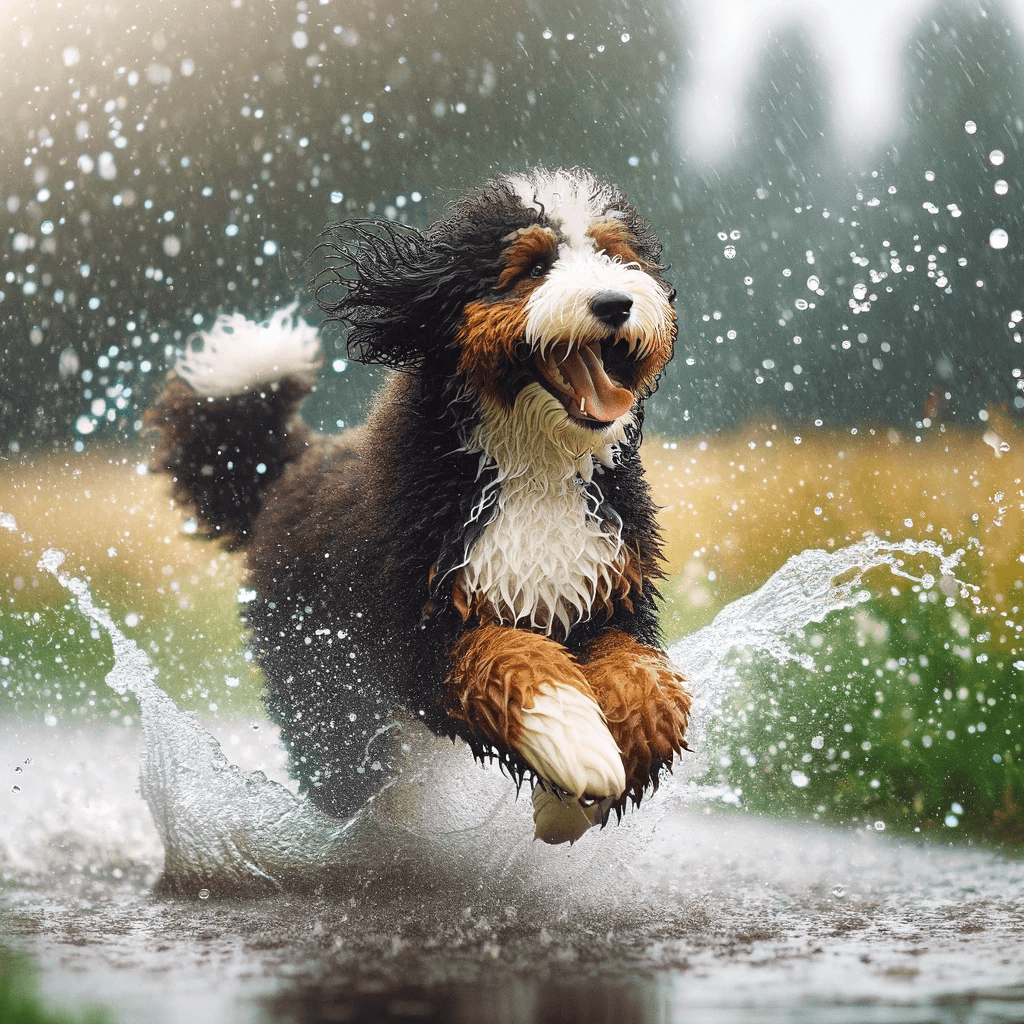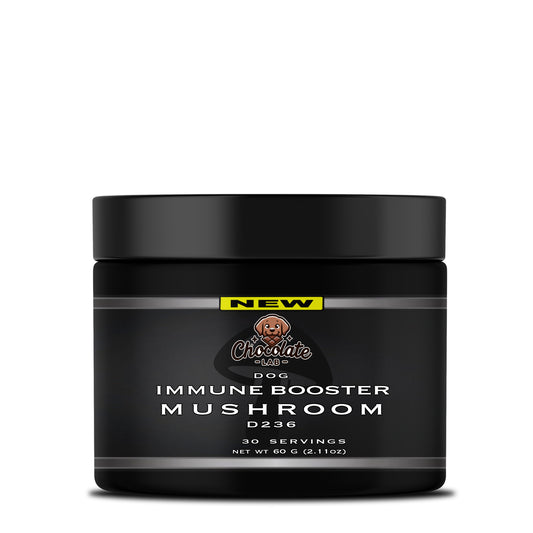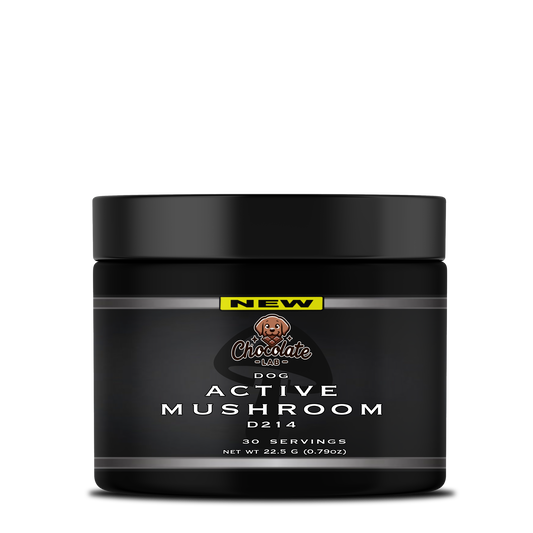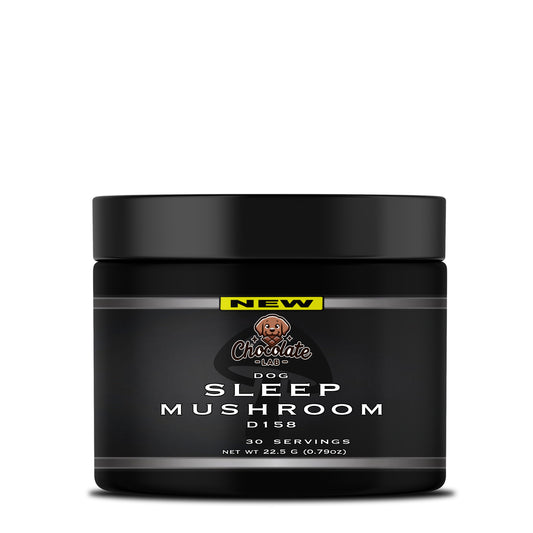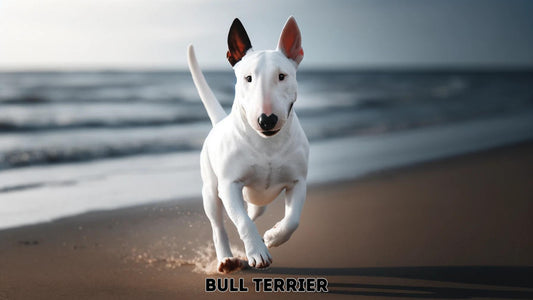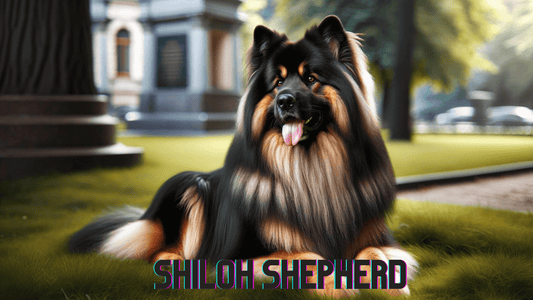Explore the World of F1B Bernedoodles! This guide offers an in-depth look into the joyful and adaptable world of F1B Bernedoodles. Whether you're a seasoned owner or a curious admirer, our comprehensive guide covers everything from their origin, physical traits, temperament, to training, health, and grooming needs.
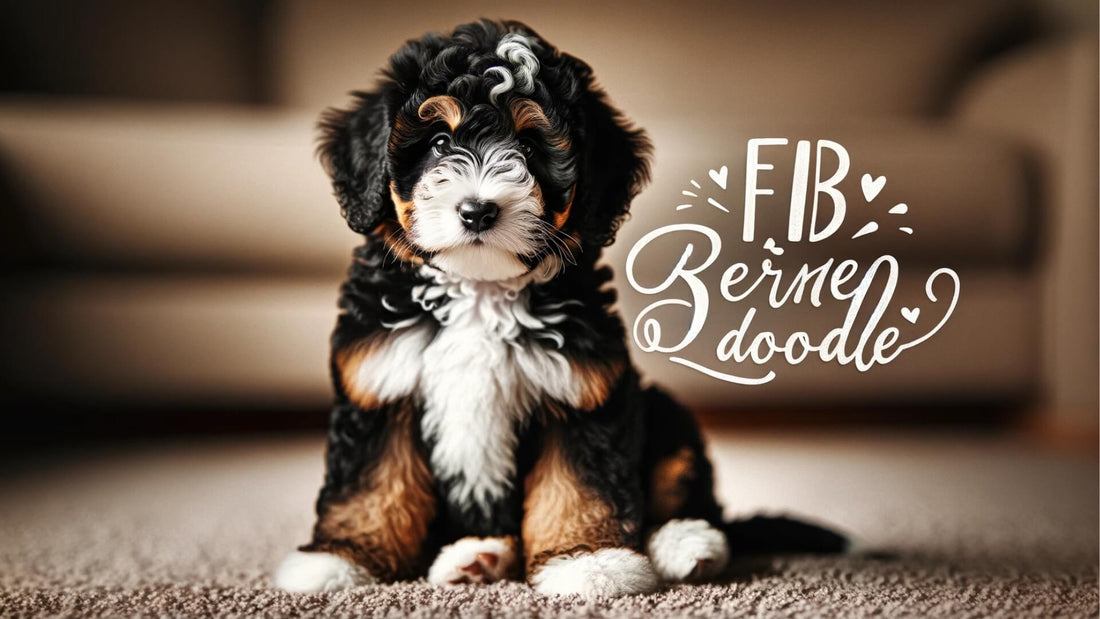
F1B Bernedoodle: Dog Breed Information, Puppies & Expert Tips
Ultimate Guide to F1B Bernedoodles: Traits, Care, and Why They're the Perfect Family Pet
Published on 01/18/2024, 11:58 PM EST
Last Updated on 01/31/2024, 5:02 PM EST
Key Takeaway: Essential Facts about the F1B Bernedoodle

| Key Aspect | Description |
|---|---|
| F1B Bernedoodle Definition | The F1B Bernedoodle is a second-generation cross, where an F1 Bernedoodle (50% Bernese Mountain Dog, 50% Poodle) is backcrossed with a Poodle, resulting in a 75% Poodle and 25% Bernese Mountain Dog hybrid. |
| Size Classification | Available in mini, medium, and standard sizes, influenced by the Poodle parent's size. |
| Coat Features | Boasts a hypoallergenic, curly, and low-shedding coat, suitable for allergy sufferers. |
| Color Variations | Exhibits a range of colors including tricolor, black, white, and brown. |
| Personality Traits | Renowned for their friendly demeanor, high intelligence, and affectionate nature. |
| Activity Requirements | Needs moderate exercise; a balance of playtime and walks is ideal. |
| Health and Lifespan | Typically has a lifespan of 12-15 years; prone to certain genetic health conditions. |
| Training and Social Behavior | Highly trainable and benefits from early socialization for well-rounded behavior. |
| Grooming Necessities | Requires regular grooming to maintain coat health; professional grooming is recommended. |
| Adaptability to Living Conditions | Well-suited for a variety of living environments, including apartments and spacious homes. |
| Financial Consideration | Initial cost can be high, with ongoing expenses for healthcare, grooming, and care. |
Table of Content
- Introduction to F1B Bernedoodles
- The F1B Bernedoodle's Origin Story
- Physical Characteristics of F1B Bernedoodles
- Understanding the F1B Bernedoodle's Temperament
- Training and Exercise Needs of F1B Bernedoodles
- Health Insights: F1B Bernedoodle Care
- Grooming and Care for F1B Bernedoodles
- F1B Bernedoodles in Family Settings
- Differences Between Male and Female F1B Bernedoodles
- Selecting an F1B Bernedoodle Puppy
- Unique Features of F1B Bernedoodles
- Pros and Cons of F1B Bernedoodles
- Cost Analysis for Owning an F1B Bernedoodle
- The Appeal of F1B Bernedoodles
- FAQs on F1B Bernedoodles
Introduction to F1B Bernedoodles

The F1B Bernedoodle, a delightful crossbreed, has captured the hearts of dog lovers worldwide. This breed combines the best traits of its ancestors: the Bernese Mountain Dog's loyalty and the Poodle's intelligence. With its increasing popularity, the F1B Bernedoodle is recognized for its friendly disposition, hypoallergenic coat, and adaptability to various lifestyles. These dogs are not just pets; they're furry family members, offering unconditional love and companionship. Their hypoallergenic quality makes them a favored choice for allergy sufferers.
With a lifespan of 12-15 years, these dogs become long-term companions. The F1B Bernedoodle is suitable for families, singles, and seniors alike, adapting seamlessly to different living environments. This breed stands out for its intelligence, making it easy to train and a joy to interact with. The F1B Bernedoodle is a testament to the successful blending of two popular breeds, resulting in a dog that's as charming as it is versatile.
Key Elements: Understanding the F1B Bernedoodle
- Definition and Breed Info: The F1B Bernedoodle is a second-generation cross, where an F1 Bernedoodle (itself a mix of Bernese Mountain Dog and Poodle) is bred back predominantly with a Poodle. This breeding strategy enhances the breed's hypoallergenic qualities, making them an excellent choice for families with allergies.
- Characteristics: These dogs are known for their plush, wavy to curly coats, available in a variety of colors including the coveted tri-color. Their size can range from mini to standard, catering to different preferences and living conditions. The temperament of F1B Bernedoodles is a harmonious blend of the affectionate nature of the Bernese Mountain Dog and the high intelligence of the Poodle, making them not only great companions but also agile and quick learners.
- Popularity Trends: In recent years, the F1B Bernedoodle has seen a surge in popularity. Their minimal shedding and hypoallergenic traits, combined with their amiable and trainable nature, make them highly sought after in the designer dog community. These qualities, along with their distinctive appearance, have contributed to their fame among both city dwellers and those in rural settings.
Detailed F1B Bernedoodle Traits Table
| Trait | Description | Notes |
|---|---|---|
| Size | Ranges from Mini to Standard | Suitable for various home sizes |
| Coat Pattern | Includes Tri-color, Bi-color, and Solid | Hypoallergenic and Low-Shedding |
| Temperament | Friendly, Intelligent, Adaptable | Great for families and singles |
| Trainability | High | Responsive to positive reinforcement |
| Lifespan | 12-15 years | Dependent on size and genetics |
| Activity Level | Moderate to High | Requires regular exercise |
Quick Tips: Ensuring a Happy Life with Your F1B Bernedoodle
- Space Considerations: They thrive in environments where they have enough space to play and explore. A home with a yard is ideal, but they can adapt well to apartment living with regular exercise.
- Family Dynamics: These dogs are great with children and other pets, making them an excellent addition to most family settings. Their gentle nature makes them safe and loving playmates for kids.
- Grooming Needs: Regular grooming is essential to maintain their coat's health and prevent matting. Investing time in grooming strengthens the bond between you and your pet.
- Exercise Requirements: Daily walks, playtime, and mental stimulation are crucial for their well-being. These activities keep them physically fit and mentally sharp, preventing boredom-related behaviors.
The F1B Bernedoodle's Origin Story

The F1B Bernedoodle is the result of an innovative breeding program aimed at combining the best qualities of the Bernese Mountain Dog and the Poodle. Originating in the early 2000s, this breed quickly gained recognition for its wonderful blend of traits. The Bernese Mountain Dog brings strength, loyalty, and a calm demeanor to the mix, while the Poodle contributes intelligence, elegance, and hypoallergenic qualities. This intentional crossbreeding has created a versatile, family-friendly dog that excels in both companionship and functionality. The F1B generation, in particular, has been bred to emphasize the hypoallergenic coat, making it a top choice for families with allergy concerns.
The evolution of this breed reflects a growing interest in designer dogs that offer both aesthetic appeal and practical benefits. The popularity of the F1B Bernedoodle continues to grow as more people discover its unique combination of beauty, brains, and hypoallergenic properties. This breed stands as a testament to thoughtful and responsible breeding practices that prioritize health, temperament, and the well-being of the dogs.
Highlights: From Bernese and Poodle to F1B Bernedoodle
- Bernedoodle History: The journey of the Bernedoodle began with the aim of creating a dog that combined the sturdiness and friendly nature of the Bernese Mountain Dog with the intelligence and low-shedding coat of the Poodle. The result was a breed that inherited the best of both worlds – the loyalty and strength of the Bernese, along with the smarts and hypoallergenic coat of the Poodle.
- The F1B Concept: The 'F1B' refers to the breeding of an F1 Bernedoodle (50% Bernese Mountain Dog, 50% Poodle) back to a Poodle. This increases the Poodle's genetic contribution to 75%, enhancing the breed's hypoallergenic qualities and often resulting in a more Poodle-like coat.
- Breeding Process and Development: The development of the F1B Bernedoodle involves careful selection and breeding to ensure the health and temperament of the dogs. Breeders focus on maintaining the breed's standard, ensuring genetic diversity, and minimizing health problems. The goal is to produce a well-rounded dog that embodies the desired traits of both parent breeds.
Detailed Lineage Table: The Bernedoodle's Evolution
| Generation | Description | Bernese Mountain Dog | Poodle | Traits Emphasized |
|---|---|---|---|---|
| F1 Bernedoodle | First cross between a Bernese Mountain Dog and a Poodle | 50% | 50% | Balanced blend of traits |
| F1B Bernedoodle | An F1 Bernedoodle bred back to a Poodle | 25% | 75% | Enhanced hypoallergenic coat, intelligence |
Advice: Spotting F1B Bernedoodle Traits
- Coat Texture: An F1B Bernedoodle typically has a curlier coat compared to an F1, reflecting the increased Poodle genetics. This coat is often softer and more hypoallergenic, making it ideal for allergy sufferers.
- Behavioral Traits: Look for the intelligent, playful, and trainable nature that is characteristic of the Poodle. F1B Bernedoodles are known for their eagerness to please and quick learning abilities.
- Physical Appearance: These dogs often have the sturdy build of the Bernese Mountain Dog but with the refined features and elegant gait of the Poodle. They may exhibit a variety of coat colors and patterns, including the popular tri-color.
Physical Characteristics of F1B Bernedoodles

The F1B Bernedoodle is a visual spectacle, boasting a coat that ranges from wavy to curly, mirroring the Poodle's influence. These dogs come in various sizes, including mini, medium, and standard, catering to different family needs and living spaces. Their coat colors are diverse, featuring beautiful hues such as black, white, brown, and the highly sought-after tri-color. This variety ensures that no two F1B Bernedoodles look exactly alike, each carrying a unique charm. Their expressive eyes, often inherited from the Bernese side, radiate warmth and intelligence.
Physically, they strike a balance between the robustness of the Bernese Mountain Dog and the elegance of the Poodle. This breed is not just about looks; their physical structure lends itself well to agility and endurance, making them suitable for various activities. Their non-shedding coat is a significant draw for families, particularly those with allergies, making them a practical choice in addition to their aesthetic appeal.
Focus Points: Unraveling Their Distinctive Appearance
- Coat Details: The coat of an F1B Bernedoodle is a defining feature, varying from soft, wavy fur to tighter curls, predominantly influenced by the Poodle genetics. The coat's texture and density offer protection from the elements while showcasing an array of beautiful patterns and colors.
- Size Variations: Size is a significant consideration when choosing an F1B Bernedoodle. Mini Bernedoodles are perfect for smaller living spaces and are easier to handle, while medium and standard sizes are better suited for families with larger homes and outdoor spaces.
- Physical Attributes: These dogs often inherit the sturdy and muscular build of the Bernese Mountain Dog, combined with the refined bone structure and agility of the Poodle. This blend results in a dog that is both strong and graceful, capable of participating in various physical activities.
Comprehensive Comparison Table: F1B Bernedoodle vs. Other Doodles
| Breed Characteristics | F1B Bernedoodle | Other Doodle Breeds |
|---|---|---|
| Coat Type | Curly/Wavy, Low to Non-Shedding | Varied, Depending on Breed Mix |
| Size Options | Mini, Medium, Standard | Varies Widely |
| Hypoallergenic Qualities | High | Varies |
| Intelligence Level | High | Generally High |
| Temperament | Friendly, Adaptable, Trainable | Varies |
Guidance: Identifying F1B Bernedoodle Hallmarks
- Coat Identification: The key to recognizing an F1B Bernedoodle is its coat. Look for the curly or wavy texture that is soft to the touch, a clear indication of the Poodle's influence in the lineage.
- Behavioral Observation: F1B Bernedoodles often display a keen intelligence and a playful, yet gentle demeanor. They are typically very sociable and enjoy being part of family activities.
- Physical Structure: Note the balanced physique that combines strength with agility. Their build is suitable for a variety of activities, from leisurely walks to more energetic play.
Understanding the F1B Bernedoodle's Temperament

The F1B Bernedoodle is celebrated for its remarkably friendly and adaptable personality, a testament to its well-thought-out breeding. These dogs exhibit a joyful disposition, often characterized by a playful and affectionate nature. They are known for their intelligence, inherited from the Poodle, making them quick learners and highly responsive to training. Their sociability extends to both humans and other animals, showcasing a gentle demeanor that makes them excellent family pets. This breed thrives on human interaction and forms strong bonds with family members, often showing a protective yet non-aggressive attitude.
F1B Bernedoodles are also known for their ability to adapt to different living situations, be it a bustling family home or a quiet apartment setting. Their even-tempered nature makes them suitable for therapy and support roles, where they can provide comfort and companionship. Additionally, these dogs possess a curious and playful spirit, bringing a sense of joy and liveliness to their household.
Key Traits: The Essence of the F1B Bernedoodle
- Friendly and Social: F1B Bernedoodles typically exhibit an outgoing and friendly personality. They enjoy being around people and are often eager to make new friends, both human and animal.
- Intelligence and Trainability: This breed's intelligence is one of its most striking features. They are quick to learn and respond well to training, making them a joy to work with. Their trainability extends to various activities, including obedience, agility, and even complex tricks.
- Family-Friendly Nature: With their affectionate and gentle disposition, F1B Bernedoodles make excellent family pets. They are known to be patient and kind with children, often forming deep bonds with the younger members of the family.
Behavior Table: A Glimpse into Their Temperament
| Trait | F1B Bernedoodle | Significance |
|---|---|---|
| Sociability | High | Great with families and other pets |
| Intelligence | High | Easy to train, enjoys mental challenges |
| Adaptability | Excellent | Comfortable in various living environments |
| Affection Level | High | Loving and loyal companions |
Raising Tips: Nurturing a Well-Balanced F1B Bernedoodle
- Early Socialization: Introduce your F1B Bernedoodle to various environments, people, and other animals early on. This exposure helps them develop into well-adjusted and confident adults.
- Consistent Training: Utilize positive reinforcement methods in training. This approach not only strengthens your bond with your pet but also encourages their natural eagerness to learn.
- Regular Exercise: Ensure they get enough physical exercise and mental stimulation. Activities such as walks, playtime, and puzzle toys help keep them physically fit and mentally engaged.
Training and Exercise Needs of F1B Bernedoodles

Training and Exercise Guide for F1B Bernedoodles
Training an F1B Bernedoodle is a rewarding experience, leveraging their high intelligence and willingness to please. These dogs excel in various training types, from basic obedience to advanced activities like agility and therapy work. Early, consistent training is key to tapping into their potential, combining mental and physical stimulation.
Positive reinforcement is highly effective with F1B Bernedoodles. Use treats, praise, and play to encourage and reinforce good behavior. This approach not only motivates them but also strengthens your bond. It's important to maintain patience and a gentle method, as they can be sensitive. Starting training early, when they are puppies, is ideal since they're more adaptable and eager to learn.
Initial Training Instructions for Basic Commands:
-
Sit:
- Hold a treat close to your dog’s nose.
- Move your hand up, allowing their head to follow the treat and causing their bottom to lower.
- Once they’re in a sitting position, say “Sit,” give them the treat, and share affection.
-
Stay:
- Ask your dog to “Sit.”
- Open your hand in front of you, and say “Stay.”
- Take a few steps back. Reward them with a treat and affection if they stay.
- Gradually increase the number of steps you take before giving the treat.
-
Come:
- Put a leash and collar on your dog.
- Get down to their level and say “Come,” while gently pulling on the leash.
- When they get to you, reward them with affection and a treat.
-
Down:
- Find a particularly good smelling treat, and hold it in your closed fist.
- Hold your hand up to your dog’s snout. When they sniff it, move your hand to the floor, so they follow.
- Slide your hand along the ground in front of them to encourage their body to follow their head.
- Once they’re in the down position, say “Down,” give them the treat, and share affection.
Essentials for Building a Strong Foundation:
- Effective Training Methods: Utilize positive reinforcement like treats, praise, and play to encourage and reinforce desired behaviors. This approach not only motivates them but also fosters a positive association with training.
- Consistency and Patience: Given their sensitive nature, it's important to be patient and consistent. Avoid negative reinforcement or punishment, as it can be counterproductive.
- Socialization: Early socialization helps in developing a well-rounded dog. Expose them to different people, environments, and other animals.
- Exercise Routines: Daily physical activity is crucial. Balance their routine with walks, play sessions, and interactive games to keep them physically and mentally stimulated.
- Mental Stimulation: These dogs need mental challenges. Incorporate puzzle toys, scent games, and varied training exercises to prevent boredom and stimulate their minds.
- Regular Training Sessions: Integrate short, frequent training sessions into their daily routine. This not only reinforces good habits but also provides mental stimulation.
- Adaptability: Be ready to adjust your training methods based on your dog's response. Each Bernedoodle may have different preferences and learning styles.
By following these guidelines, you can effectively train and exercise your F1B Bernedoodle, ensuring a well-behaved, happy, and healthy companion. Remember, training is an ongoing process that strengthens the bond between you and your dog while fostering their physical and mental well-being.
Training and Exercise Needs of F1b Bernedoodles
| Training Aspect | Description | Frequency | Duration | Tips/Techniques |
|---|---|---|---|---|
| Basic Obedience Training | Teaching commands like sit, stay, come, and heel | Daily | 15-20 mins | Positive reinforcement, consistency |
| Socialization | Exposing to different people, animals, and environments | Several times a week | Varies | Gradual introduction, patience |
| Exercise Needs | Physical activities like walking, playing | Daily | 30-60 mins | Interactive toys, varied activities |
| Mental Stimulation | Puzzle toys, training exercises | Daily | 20-30 mins | Rotate toys, challenge with new tasks |
| Leash Training | Walking comfortably on a leash | Daily | 15-20 mins | Gentle lead, reward-based training |
| Crate Training | Teaching to stay calmly in a crate | As needed | Varies | Comfortable bedding, gradual training |
Activity Ideas: Ensuring a Happy, Engaged Dog
- Hide-and-Seek Games: Use treats or their favorite toys to play hide-and-seek, which stimulates their scent tracking abilities and provides mental enrichment.
- DIY Agility Course: Set up a simple agility course in your yard or at a park. This not only provides physical exercise but also engages them mentally as they navigate the course.
Health Insights: F1B Bernedoodle Care

The health of your F1B Bernedoodle is paramount. Generally, these dogs enjoy robust health, thanks to the careful breeding practices that aim to minimize genetic health issues. However, like all breeds, they are predisposed to certain conditions inherited from their parent breeds. Regular veterinary check-ups, a balanced diet, and adequate exercise are key to maintaining their health.
Understanding and addressing their health needs early on can lead to a longer, happier life for your pet. It's important to stay informed about the common health concerns associated with both the Bernese Mountain Dog and the Poodle, as this knowledge can help in early detection and treatment. A proactive approach to their health care, including vaccinations, parasite control, and regular health screenings, can prevent many common issues.
Key Points: Staying Ahead of Health Concerns
- Potential Health Issues: Be aware of hereditary conditions such as hip dysplasia, von Willebrand's disease, and certain eye conditions. Regular health screenings can help in early detection and management of these issues.
- Lifespan Influencing Factors: Factors such as diet, exercise, genetics, and overall care play a significant role in determining their lifespan. F1B Bernedoodles typically enjoy a lifespan of 12-15 years, depending on these factors.
- Preventative Measures: Ensure your F1B Bernedoodle maintains a healthy weight to avoid stress on joints. Provide a balanced diet, regular exercise, and mental stimulation to keep them healthy and happy.
Detailed Health Table: Key Health Aspects
| Health Aspect | Details | Prevention/Management |
|---|---|---|
| Hip Dysplasia | Joint condition, can be genetic | Regular exercise, proper diet, veterinary check-ups |
| Eye Conditions | Includes cataracts, glaucoma | Regular eye examinations, genetic screening |
| Skin Allergies | Can occur due to environmental factors | Proper grooming, diet, and veterinary care |
Care Tips: Ensuring a Healthy Lifestyle
- Dietary Management: Feed them high-quality dog food suitable for their age, size, and activity level. Avoid overfeeding to prevent obesity, which can lead to health complications.
- Regular Exercise: Keep them active with daily walks, play sessions, and mental challenges. Exercise is crucial for maintaining their physical and mental health.
- Routine Vet Visits: Regular veterinary check-ups can help catch any health issues early. Keep up with vaccinations and preventive treatments for parasites.
Grooming and Care for F1B Bernedoodles

Detailed Guide to Grooming and Care for F1B Bernedoodles
Grooming an F1B Bernedoodle is essential for their health and well-being, requiring special attention due to their unique coat, inherited from both the Poodle and Bernese Mountain Dog. Their coats can vary from wavy to curly, and while being low-shedding, they are prone to matting without proper care. This makes regular grooming not just about aesthetics but a necessity for their comfort and health.
Routine brushing is crucial to prevent tangles and mats, keeping their fur shiny and healthy. Additionally, comprehensive grooming includes nail trimming, ear cleaning, and dental care. For handling intricate grooming tasks like precise trimming, professional grooming services every few months are beneficial.
A well-groomed F1B Bernedoodle is not only visually appealing but also more comfortable and healthier, highlighting the importance of a consistent grooming regimen for these unique dogs.
Key Aspects: Comprehensive Care Routine
-
Coat Maintenance: F1B Bernedoodles typically have wavy to curly coats that are low-shedding, ideal for allergy sufferers. However, this type of coat can easily mat without regular care.
- Brushing: Frequent brushing, at least three times a week, is crucial to prevent matting and keep the coat glossy and healthy. For curlier coats, daily brushing might be necessary.
- Bathing: Bathe your Bernedoodle every 4-6 weeks, or as needed, using a dog-specific shampoo that won't strip their coat of natural oils.
- Professional Grooming: Regular appointments with a professional groomer (every 3-4 months) are recommended. They can expertly handle tasks like hair trimming, especially around the feet and eyes, and thorough ear cleaning.
- Skin and Coat Health Through Nutrition: A balanced diet enriched with omega-3 fatty acids contributes significantly to the health and luster of their coat. Foods rich in these nutrients can help keep their fur soft and reduce skin irritation.
-
Routine Health Care:
- Dental Care: Regular dental check-ups and cleaning are vital. Incorporate teeth brushing into their routine to prevent dental diseases.
- Nail Trimming: Regular nail trimming is important to avoid discomfort and mobility issues. This can be done monthly or as needed.
- Ear Care: Clean their ears regularly to prevent infections, especially since Bernedoodles can have floppy ears prone to moisture accumulation.
- Regular Health Check-ups: Apart from at-home care, ensure your F1B Bernedoodle receives regular veterinary check-ups to maintain overall health and catch any issues early.
- Seasonal Considerations: Depending on the climate, their grooming needs may change. For instance, in warmer months, they might require more frequent trims to stay cool.
- Grooming Tools: Invest in quality grooming tools like a slicker brush, a wide-toothed comb, and safe nail clippers. Using the right tools makes grooming more efficient and comfortable for your pet.
- Training for Grooming: It's beneficial to acclimate your Bernedoodle to grooming from an early age. Regular, gentle handling of paws, ears, and mouth can make them more comfortable with the grooming process.
By adhering to these grooming practices, your F1B Bernedoodle will not only look their best but also enjoy a comfortable and healthy life. Remember, grooming is not just about aesthetics; it's an essential part of their overall care.
Grooming Needs of F1b Bernedoodles
| Grooming Aspect | Frequency | Tools/Products | Tips |
|---|---|---|---|
| Brushing | 2-3 times/week | Slicker brush, comb | Gentle strokes, detangle first |
| Bathing | Monthly | Dog shampoo, conditioner | Avoid over-bathing, rinse well |
| Nail Trimming | Monthly | Nail clippers, grinder | Trim carefully, avoid quick |
| Ear Cleaning | Bi-weekly | Ear cleaner, cotton balls | Check for infections, be gentle |
| Dental Care | Daily | Toothbrush, dog toothpaste | Brush gently, reward afterwards |
| Haircuts | Every 6-8 weeks | Professional groomer | Maintain breed-specific style |
Grooming Tips: Mastering the Art of Maintenance
- Choosing the Right Tools: Invest in a high-quality brush suitable for their coat type, such as a slicker brush or a pin brush, to effectively remove tangles and loose fur.
- Bathing Techniques: Ensure the water temperature is comfortable. Gently massage the shampoo into their coat, taking care not to get water or soap in their ears or eyes.
- Professional Grooming: Consider professional grooming services every few months, especially for haircuts and thorough cleaning, which can be challenging to do at home.
F1B Bernedoodles in Family Settings

F1B Bernedoodles are renowned for their excellent compatibility with families. Their gentle and affectionate nature makes them wonderful companions for children of all ages. They are known for their patience and playfulness, often forming strong bonds with family members. These dogs are typically good with other pets, making them a great addition to a household with multiple animals.
Early socialization is key to ensuring they grow up to be well-rounded and comfortable around various people and animals. Training for family integration, such as basic obedience and manners, is essential to ensure they fit seamlessly into the family dynamic. Their adaptable nature means they can thrive in both active households and more relaxed environments. The joy and companionship an F1B Bernedoodle brings to a family are immeasurable, making them a cherished member of any home.
Behavioral Aspects: Thriving in a Family Environment
- Family Pet Potential: F1B Bernedoodles have a natural affinity for being part of a family. They enjoy being involved in family activities and are known for their loyalty and affectionate behavior.
- Children and Pet Interactions: These dogs are generally very good with children, displaying patience and gentleness. They also tend to get along well with other pets, especially when introduced at a young age.
- Training for Socialization: Training plays a crucial role in integrating an F1B Bernedoodle into a family. Basic training, along with socialization exercises, can help them understand boundaries and behave appropriately in a family setting.
Detailed Family Rating Table: Assessing Their Suitability
| Family Aspect | Compatibility Rating | Notes |
|---|---|---|
| With Children | High | Patient and gentle with kids |
| With Other Pets | High | Sociable with other animals |
| In Active Households | Moderate to High | Adaptable to various activity levels |
| Trainability | High | Responsive to family-oriented training |
Social Tips: Introducing Your Bernedoodle to the Family
- Gradual Introduction: Introduce your F1B Bernedoodle to family members and other pets slowly and in a controlled environment. This approach helps them feel comfortable and secure, fostering positive interactions.
- Establishing a Routine: Consistency is key. Establishing a routine for feeding, walking, and playtime helps the dog understand what to expect, providing a sense of security and belonging.
- Involving the Family in Care: Encourage all family members to participate in caring for the F1B Bernedoodle. This involvement strengthens the bond between the dog and each family member, promoting mutual respect and affection.
- Monitoring Interactions: Always supervise interactions between the dog and young children to ensure safety for both. Teach children how to interact with the dog respectfully and gently.
- Socialization Activities: Engage in socialization activities that expose the dog to different environments, sounds, and experiences. This broadens their comfort zone and enhances their adaptability.
- Positive Reinforcement: Use positive reinforcement to encourage good behavior around family members and other pets. Rewards and praise make the learning process enjoyable and effective for the dog.
- Setting Boundaries: It’s important to establish and maintain boundaries to ensure the dog understands its limits within the family setting. Consistent training and clear communication are crucial for this.
- Patience and Understanding: Remember that every dog is unique. Patience and understanding are essential as your F1B Bernedoodle adjusts to life in a family environment.
Differences Between Male and Female F1B Bernedoodles

While male and female F1B Bernedoodles share many similar traits, subtle differences can be observed in their behavior, physicality, and health. Understanding these differences can help potential owners make informed decisions when choosing a new pet. Male F1B Bernedoodles are often larger and may exhibit more dominant behaviors, while females might be more independent and reserved.
In terms of health, certain conditions may be more prevalent in one gender than the other, making it important to be aware of these aspects when caring for your pet. Additionally, spaying or neutering can influence the behavior and health of the dog, often mitigating gender-specific traits and health risks.
Differences: Male vs. Female F1B Bernedoodles
- Gender-specific Behaviors: Males may display more assertive behavior and tend to be more playful and outgoing. Females, on the other hand, might be more independent and can be more cautious in new situations.
- Physical Differences: Generally, male F1B Bernedoodles are larger in size and may have a more robust build compared to their female counterparts. Females often mature faster than males, both physically and mentally.
- Health Considerations: Being aware of gender-specific health issues is important. For instance, males might be more prone to certain conditions like hip dysplasia, while females may have different reproductive health concerns.
Detailed Comparison Table: Male vs. Female F1B Bernedoodles
| Aspect | Male F1B Bernedoodle | Female F1B Bernedoodle | Notes |
|---|---|---|---|
| Size | Generally Larger | Usually Smaller | Consider size when choosing |
| Behavior | More Playful and Assertive | More Independent and Reserved | Can vary with individual dog |
| Health Concerns | Specific Male-related Issues | Specific Female-related Issues | Important for veterinary care |
Selection Guide: Choosing Based on Your Lifestyle
- Considering Family Dynamics: Think about your household’s lifestyle and the dynamics when choosing between a male and female F1B Bernedoodle. Both genders can make wonderful pets, but their subtle differences might align better with certain family situations.
- Personal Preferences: Some people may have a preference for a specific gender based on previous experiences or personal comfort. It’s important to choose a pet that you feel a connection with, as this will foster a stronger bond.
- Spaying/Neutering Impacts: Consider the implications of spaying or neutering, which can affect a dog’s behavior and health. This might influence your decision on which gender to choose.
Selecting an F1B Bernedoodle Puppy

Comprehensive Guide to Choosing an F1B Bernedoodle Puppy
Choosing an F1B Bernedoodle puppy is a significant decision that extends beyond mere appearance. To ensure a healthy, well-adjusted companion, potential owners must consider several key factors, including the breeder's credibility, the puppy's health, and temperament. Here’s an in-depth guide to making an informed choice:
- Understanding Breeder Reputation: Seek breeders who are transparent and ethical. A reputable breeder will openly discuss their breeding practices and show a deep commitment to the health and well-being of their dogs. They should be affiliated with recognized breeding associations and adhere to ethical breeding standards.
- Importance of Health Testing: Inquire about the health screening of the parent dogs. Reputable breeders conduct genetic testing to screen for common hereditary diseases in both Bernese Mountain Dogs and Poodles. This testing helps minimize the risk of genetic health issues in puppies.
- Examining Health and Vaccination Records: Ensure the puppy has a complete health check, up-to-date vaccinations, and deworming. A health record provides a clear history of the puppy's medical care.
- Observing Puppy’s Behavior: Spend quality time with the puppies to assess their temperament. Look for signs of a well-socialized puppy, such as playfulness, curiosity, and a balanced level of confidence. Avoid puppies that are excessively shy or aggressive.
- Parent Dogs’ Health and Temperament: Information about the parent dogs can offer valuable insights into your puppy's future health and behavior. Inquire about their temperament and health history.
- Checking Living Conditions: The environment where the puppies are raised significantly impacts their development. Look for clean, spacious, and nurturing settings.
- Socialization and Early Experiences: Puppies should be exposed to various environments and stimuli early on. This exposure is crucial for their social and emotional development.
- Breeder Support and Guidance: A responsible breeder will provide guidance on caring for the puppy and be available for any future questions or concerns. This ongoing support is invaluable for first-time dog owners.
- Making a Thoughtful Decision: Remember, adopting a puppy is a long-term commitment. Evaluate how the puppy's temperament aligns with your lifestyle and be prepared for the responsibilities of dog ownership.
Checklist for Selecting an F1B Bernedoodle Puppy:
- Breeder's Reputation: Verify their credibility and ethical standards.
- Health and Genetic Testing: Confirm comprehensive health screening and genetic testing of parent dogs.
- Puppy's Health Records: Review vaccination and deworming history.
- Temperament Assessment: Spend time with the puppies to understand their individual personalities.
- Parent Dogs’ Information: Gather information about the health and temperament of the parent dogs.
- Living Conditions: Inspect the environment where the puppies are raised.
- Socialization Practices: Check the level of socialization and exposure the puppies have received.
- Breeder's Support: Ensure the breeder offers ongoing support and guidance.
By following these guidelines, you can select an F1B Bernedoodle puppy that is not only healthy and well-adjusted but also a perfect fit for your family and lifestyle.
Detailed Breeder Criteria Table: Evaluating Breeders
| Criteria | Importance | Details |
|---|---|---|
| Health Clearances | Essential | Confirm health screenings and clearances for genetic conditions |
| Breeding Ethics | High | Ethical breeding practices, prioritizing animal welfare |
| Puppy Socialization | Important | Early socialization for well-adjusted puppies |
| Post-Adoption Support | Valuable | Availability for ongoing guidance and support |
Purchase Tips: Ensuring the Best Match
- Visit in Person: If possible, visit the breeder's facility in person. This allows you to observe the puppies' environment and interact with them directly.
- Ask Questions: Don’t hesitate to ask the breeder questions about the puppy's care, feeding, and any special needs.
- Observe the Litter: Spend time observing the litter. Each puppy's behavior can give you insights into its personality and temperament.
- Health Guarantee: Look for breeders who offer a health guarantee. This shows their confidence in the puppies' health and their commitment to responsible breeding.
- Trust Your Instincts: Trust your intuition when selecting a puppy. The right puppy for you should feel like a natural fit with your family and lifestyle.
Unique Features of F1B Bernedoodles

The F1B Bernedoodle is celebrated for a set of unique characteristics that distinguish it from other breeds. These dogs are known for their charming "teddy bear" appearance, combining the sturdy build of the Bernese Mountain Dog with the elegant, curly coat of the Poodle. The F1B generation typically exhibits a higher degree of the Poodle's hypoallergenic and non-shedding coat, making them ideal for families with allergy concerns. Their intelligence is notable, often displayed in their quick learning ability and problem-solving skills.
The temperament of the F1B Bernedoodle is a harmonious blend of the Bernese's calm and the Poodle's playful nature, resulting in a well-balanced and adaptable companion. They also inherit the Poodle's love for water and swimming, alongside the Bernese's endurance, making them excellent partners for various outdoor activities. These dogs are not only beautiful but also possess a gentle, loving disposition, often making them great therapy dogs. Their versatility in size, ranging from mini to standard, allows them to fit into a variety of living situations, from apartments to large homes with yards.
Comparing F1B Bernedoodles with Goldendoodles and Labradoodles: A Detailed Overview
| Breed Characteristics | F1B Bernedoodle | Goldendoodle | Labradoodle |
|---|---|---|---|
| Size | Medium to Large | Small to Large | Medium to Large |
| Coat Type | Wavy to Curly | Straight to Curly | Wavy to Curly |
| Shedding | Minimal | Minimal to Moderate | Minimal to Moderate |
| Allergen Potential | Low | Low to Moderate | Low to Moderate |
| Temperament | Friendly, Intelligent, Affectionate | Intelligent, Friendly, Outgoing | Friendly, Energetic, Good-natured |
| Energy Level | Moderate to High | High | High |
| Life Expectancy | 12-15 years | 10-15 years | 12-14 years |
| Health Issues Common | Hip dysplasia, Skin issues | Hip dysplasia, Ear infections | Hip dysplasia, Elbow dysplasia |
Features: A Closer Look at What Sets Them Apart
- Breed-Specific Attributes: The F1B Bernedoodle typically has a more hypoallergenic coat than the F1 generation, reflecting the higher percentage of Poodle genetics. This makes them particularly appealing to families concerned about allergies.
- Comparison with F1 Bernedoodles: While F1 Bernedoodles have a balanced mix of traits from both parent breeds, F1B Bernedoodles tend to exhibit more Poodle-like characteristics, especially in their coat type and temperament.
- Unique Skills and Abilities: Their intelligence and trainability make them excellent candidates for various roles, including therapy and assistance work. They are also great at dog sports like agility, owing to their agility and enthusiasm.
In-depth Trait Table: Highlighting F1B Bernedoodle Characteristics
| Feature | F1B Bernedoodle | Notes |
|---|---|---|
| Coat Type | Curly or Wavy, Hypoallergenic | Ideal for allergy sufferers |
| Size Range | Mini, Medium, Standard | Suitable for various living situations |
| Temperament | Friendly, Adaptable, Intelligent | Great family pets |
| Trainability | High | Responsive to training, good for first-time owners |
| Activity Level | Moderate to High | Needs regular exercise and mental stimulation |
| Suitability for Therapy | High | Gentle nature makes them great therapy dogs |
Fun Facts: Delving into the World of F1B Bernedoodles
- "Teddy Bear" Look: Their adorable appearance often resembles a plush teddy bear, endearing them to people of all ages.
- Water Enthusiasts: Many F1B Bernedoodles inherit the Poodle's love for water, making them great companions for beach trips and pool time.
- Versatile Companions: They adapt well to various lifestyles, whether it's accompanying their owner on a hike or cuddling on the couch.
Pros and Cons of F1B Bernedoodles

When considering adding an F1B Bernedoodle to your life, it's important to weigh both the pros and cons. These dogs offer numerous advantages, such as their adaptable and friendly nature, intelligence, and hypoallergenic coat. However, they also come with certain challenges. Their grooming needs are significant, requiring regular brushing and professional grooming to maintain their coat.
As intelligent and active dogs, they require mental and physical stimulation to prevent boredom and destructive behaviors. The financial and time commitments for their care can be substantial, including costs for food, grooming, veterinary care, and possible training classes. Understanding these aspects is crucial for a potential owner to ensure a happy and harmonious life with an F1B Bernedoodle.
Key Aspects: The Full Spectrum
- Benefits: The F1B Bernedoodle is an adaptable, intelligent, and generally healthy breed. They are great for families, singles, and seniors, fitting well into various home environments. Their hypoallergenic coat is a significant advantage for allergy sufferers.
- Grooming Challenges: They require regular grooming to keep their coat in good condition. This includes frequent brushing and professional grooming sessions, which can be time-consuming and costly.
- Time and Financial Commitment: Owning an F1B Bernedoodle involves a commitment to their exercise, training, and health needs. This includes costs for high-quality food, grooming supplies, veterinary care, and potential training classes.
Detailed Pros & Cons Table: A Comprehensive Comparison
| Pros | Cons |
|---|---|
| Friendly and Adaptable Nature | Requires Regular and Detailed Grooming |
| High Intelligence and Trainability | Can Be Expensive in Long-term Care |
| Hypoallergenic Coat, Ideal for Allergy Sufferers | Needs Ample Mental and Physical Stimulation |
| Good Health and Longevity | May Require Training for Optimal Behavior |
| Excellent Family Pet | Financial Commitment for Health and Maintenance |
Consideration Tips: Making the Right Choice
- Assess Your Lifestyle: Consider if you can meet the exercise and mental stimulation needs of an F1B Bernedoodle. They thrive in active environments where they can be part of the family activities.
- Budget Planning: Factor in the ongoing costs of food, grooming, and healthcare. Ensure you are prepared for the financial commitment that comes with owning an F1B Bernedoodle.
- Space and Environment: Evaluate your living space to ensure it's suitable for an F1B Bernedoodle, especially if you're considering a larger size.
- Long-term Commitment: Remember, bringing a dog into your life is a long-term commitment. Consider the implications on your lifestyle, time, and finances.
Cost Analysis for Owning an F1B Bernedoodle

Owning an F1B Bernedoodle is a significant financial commitment, encompassing various expenses that extend beyond the initial purchase price. Prospective owners should consider not only the cost of acquiring the puppy but also the ongoing expenses related to its care. These expenses include routine veterinary care, high-quality dog food, grooming supplies, and potential emergency medical costs. Regular expenses such as grooming, health check-ups, vaccinations, and parasite prevention are crucial for maintaining the health and well-being of your F1B Bernedoodle.
It's also important to factor in costs for training classes, especially for first-time dog owners, as well as accessories like beds, leashes, and toys. Additional expenses might arise, such as pet insurance and boarding or pet-sitting fees during travel. Being financially prepared for both expected and unexpected costs ensures a comfortable and stress-free life for both the dog and its owner.
Expense Details: Breaking Down the Costs
- Initial Purchase Price: The cost of an F1B Bernedoodle puppy can vary widely based on the breeder, location, and the puppy's characteristics. Prices typically range from $1,500 to $3,000.
- Routine Care Costs: Monthly expenses for high-quality dog food, grooming supplies, and routine vet care can add up. An average monthly estimate for these expenses ranges from $100 to $200.
- Healthcare and Emergency Costs: Setting aside funds for unexpected health issues or emergencies is important. This includes costs for treatments, surgeries, or any special medical needs that may arise.
- Training and Socialization: Budget for training classes, especially if you're a first-time dog owner. Training is crucial for the dog's behavior and socialization.
- Pet Insurance: Consider investing in pet insurance to help cover unexpected medical expenses. Insurance plans vary, so choose one that best fits your needs and budget.
Detailed Budget Table: Financial Planning for Your F1B Bernedoodle
Cost Analysis of F1b Bernedoodles
| Cost Type | Initial Cost ($) | Monthly Cost ($) | Annual Cost ($) | Notes/Details |
|---|---|---|---|---|
| Puppy Purchase | 2,000 - 5,000 | - | - | Breeder reputation affects price |
| Veterinary Care | 100 - 300 | 30 - 70 | 500 - 1,000 | Vaccinations, check-ups, emergencies |
| Food and Treats | 50 - 100 | 60 - 120 | 720 - 1,440 | High-quality diet, size-dependent |
| Grooming | 30 - 60 | 50 - 100 | 600 - 1,200 | Professional grooming, tools |
| Training | 100 - 500 | 20 - 100 | 240 - 1,200 | Classes, resources |
| Accessories | 100 - 300 | 10 - 50 | 120 - 600 | Bed, leash, toys, crate |
| Pet Insurance | - | 30 - 50 | 360 - 600 | Optional, varies by coverage |
Saving Tips: Managing Your Bernedoodle Budget
- Smart Shopping: Look for deals and discounts on dog food and supplies. Buying in bulk or during sales can save costs in the long run.
- Preventive Care: Invest in preventive healthcare to avoid more significant expenses down the line. This includes regular vet check-ups, vaccinations, and maintaining a healthy lifestyle.
- DIY Grooming: Learn basic grooming techniques to handle some of the grooming needs at home. This can reduce the frequency of professional grooming visits.
- Training at Home: Consider training your dog at home using online resources and books, which can be a cost-effective alternative to professional classes.
The Appeal of F1B Bernedoodles

The F1B Bernedoodle is more than just a pet; it's a loving, intelligent companion that brings immense joy and affection into your life. Their adaptable nature makes them suitable for a wide range of owners, from families with children to single adults. Their hypoallergenic coat is a boon for allergy sufferers, and their playful, affectionate demeanor makes every day brighter. These dogs are not only a delight to look at but also bring a level of companionship that enriches the lives of their owners.
The commitment to owning an F1B Bernedoodle is substantial, but the rewards are immeasurable. They offer unconditional love, loyalty, and endless moments of happiness, making them a beloved member of any family. The decision to welcome an F1B Bernedoodle into your home should be made with careful consideration of all the responsibilities and joys that come with it.
Reflection Points: Contemplating Bernedoodle Ownership
- Lifestyle Impact: Consider how an F1B Bernedoodle will fit into your daily life. Their need for exercise, mental stimulation, and companionship should align with your lifestyle and routine.
- Long-term Commitment: Remember that bringing a dog into your life is a commitment that spans many years. Think about how your circumstances might change and whether you can continue to provide for the dog's needs.
- The Joy of Companionship: Owning an F1B Bernedoodle brings a unique joy and fulfillment. They are not just pets but loyal friends who offer comfort, fun and unconditional love.
- Family Integration: If you have a family, consider how the dog will fit in with family members, including children and other pets. The F1B Bernedoodle's adaptable and friendly nature typically makes them a great addition to most families.
Summary Table: Key Takeaways
| Aspect | Detail |
|---|---|
| Temperament | Friendly, Adaptable, Intelligent |
| Grooming Needs | High; Regular Maintenance Required |
| Training | Responsive and Enjoyable to Train |
| Health and Longevity | Generally Healthy with a Lifespan of 12-15 Years |
| Financial Commitment | Significant; Includes Initial Cost and Ongoing Care |
Final Recommendations: Embracing the Bernedoodle Life
- Thorough Research: Before deciding, research thoroughly to understand all aspects of F1B Bernedoodle ownership. This includes their care needs, temperament, and potential health issues.
- Preparation: Prepare your home and lifestyle for the arrival of your new companion. This includes creating a safe, welcoming space and adjusting your routine to accommodate their needs.
- Ongoing Learning: Stay informed about the best practices for caring for your F1B Bernedoodle. This includes staying up-to-date on health care, nutrition, and training techniques.
FAQs on F1B Bernedoodles

Detailed FAQ Table: Navigating Your Bernedoodle Curiosities
| No. | Question | Answer |
|---|---|---|
| 1 | What is an F1B Bernedoodle? | An F1B Bernedoodle is a crossbreed where an F1 Bernedoodle is bred back predominantly with a Poodle. |
| 2 | How big do F1B Bernedoodles get? | They can range from mini to standard size, depending on the size of the Poodle in their lineage. |
| 3 | Are F1B Bernedoodles hypoallergenic? | Yes, they are more hypoallergenic than F1 Bernedoodles, thanks to their higher Poodle genetic makeup. |
| 4 | How much exercise does an F1B Bernedoodle need? | They require regular exercise, including daily walks and playtime, to stay healthy and happy. |
| 5 | What is the lifespan of an F1B Bernedoodle? | They typically live for 12-15 years, depending on factors like genetics, diet, and exercise. |
| 6 | Are F1B Bernedoodles good family pets? | Yes, they are known for their friendly and adaptable nature, making them excellent family pets. |
| 7 | How intelligent are F1B Bernedoodles? | They are highly intelligent, inheriting the smartness of the Poodle and the trainability of the Bernese Mountain Dog. |
| 8 | What are the grooming needs of an F1B Bernedoodle? | They require regular grooming, including brushing and professional grooming, due to their curly or wavy coat. |
| 9 | Can F1B Bernedoodles live in apartments? | Yes, they can adapt to apartment living if they receive adequate exercise and mental stimulation. |
| 10 | Are F1B Bernedoodles prone to any health issues? | Like any breed, they can be prone to certain health issues, but responsible breeding practices help minimize these risks. |
| 11 | How often should an F1B Bernedoodle be bathed? | Typically, once every 2-3 months, or as needed, depending on their coat and lifestyle. |
| 12 | Is it easy to train an F1B Bernedoodle? | Yes, their intelligence and eagerness to please make them relatively easy to train. |
| 13 | What should I feed my F1B Bernedoodle? | A balanced diet suitable for their age, size, and activity level is recommended. Consult a vet for specific dietary needs. |
| 14 | Do F1B Bernedoodles get along with other pets? | Generally, yes. They are sociable and can coexist peacefully with other pets, especially if socialized early. |
| 15 | How much does it cost to own an F1B Bernedoodle? | Initial costs can range from $1,500 to $3,000, with ongoing expenses for food, grooming, and healthcare. |

